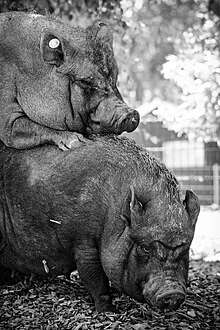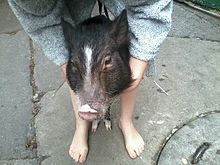Miniature pig
 An adult Göttingen Minipig | |
| Conservation status | DOM |
|---|---|
| Traits | |
| |
Miniature pigs, also called mini pigs, are small breeds of domestic pig.
All domesticated pigs are descended from the European or Asian wild boar.[1] They reach sexual maturity at four to eight months and must be castrated if they are kept together with the opposite sex. They reach their full height at four years of age. Depending on the breed, they reach up to 50 cm (20 in) at the shoulder and are up to 1 meter (3 ft 3 in) long. Mini pigs weigh up to 150 pounds (68 kg) and live around 15 years.[2] Miniature pigs can usually be distinguished from other pigs by their pot belly, a swayed back, a chubby figure, a rounded head, a short snout, short legs, a short neck, and a tail with thick hair at the end.[3]
Terms like “teacup,” “micro-mini,” and “nano-pig” are advertising, not real breeds.[3]
History
[edit]The first mini pig breed developed in the United States was the Minnesota minipig, which emerged in the 1940s.[4][5]
In the 1960s, Vietnamese Pot-bellied pigs that grew up to 91 kilograms (200 lb) were sent to zoos in Western cities[6] and were used for medical research in the fields of toxicology, pharmacology, pulmonology, cardiology, aging, and as a source of organs for organ transplantation.[7] These comparatively smaller pigs were easier to work with than larger pig breeds, which typically reach weights of 600 lb (270 kg).[8]
Beginning in the late 1960s at the Institute of Animal Breeding and Genetics (Institut für Tierzucht und Haustiergenetik) at the University of Göttingen, Germany, the Göttingen minipig was developed by crossbreeding the Minnesota minipig, the Vietnamese Pot-Bellied pig and the German Landrace pig.[9]

In the mid-1980s, the Bowmanville Zoo in Ontario imported breeding Vietnamese Pot-Bellied pigs to Canada, which became the foundation for the pot-bellied pig in North America.[10] The breed is known for its small stature, swayed back, and pronounced pot belly. Because of custom laws, only their offspring could be sold in the United States. U.S. zoos were the main target for the offspring. [11][12][13]
Up to five additional imports were made in the following 10 years. To track the pedigrees, the Potbellied Pig Registry Service, Inc (PPRSI) was created to preserve these bloodlines and establish a breed registry in the United States. This registry was dissolved in the late 1990s.[10] Today, most pot-bellied pigs are seldom to never purebred, as the pure breed is critically endangered.
Medical research
[edit]Miniature pigs have been used for medical research, including toxicology, pharmacology, experimental surgery, pulmonology, cardiology, xenotransplantation, orthopedic procedures[14] and aging studies. Mini pigs are mainly used for biochemical, anatomical, and physiological similarities to humans. They are also quick to develop, making it easier to breed and have more genomic background compared to other animal models of toxicology. Today, more than 60,000 pigs are used for scientific research.[15][16][17] For example, scientists are working on studying the possibility of utilizing pig hearts for human heart organ transplants, and work has been done to genetically modify the tissues of pigs to be accepted by the human immune system.[18]
As pets
[edit]
Miniature pigs are also kept as pets. Realistic sizes of pigs vary from pig to pig; genetics drives the growth, along with appropriate nutrition and care. Miniature pigs weigh up to 150 pounds (68 kg). However, since pigs can breed years before they fully mature, unscrupulous or ignorant breeders may show off parent pigs which are not fully grown themselves and have not reached their full adult size.[19]
In the U.S. as well as Canada, laws may vary on if a pet pig can be kept, depending on the location. If there are no laws regarding pet pigs, some areas may consider a pig to be exclusively known as livestock; some towns and cities have ordinances disallowing farm animals within city limits. However, one can petition city councils and have outdated ordinances amended before a pig is introduced into a household, since many ordinances were put into place before the pot-bellied pig was even introduced to the U.S.[20]
Pig therapy
[edit]Pigs have been used in various types of animal-assisted therapy to perform duties in facilities including airports,[21][22] hospitals,[23] nursing homes,[24] and special-needs schools, or as emotional support animals for individuals with conditions such as autism or anxiety[25] and veterans with PTSD.[26] Two well-known miniature pigs named Thunder and Bolt trained by children to certified animal therapy status have been put to work in a number of nursing homes, schools and a hospital.[23]
Other notable references
[edit]A Yucatan miniature pig is the unofficial mascot of the Animal Rescue League of Boston.[27]
The world's smallest wild pig species is the 71 centimetres (28 in) long wild pygmy hog which lives in Assam, India.[28] It is a critically endangered wild species, not appropriate for domestication.[29]
See also
[edit]References
[edit]- ^ V. Porter: Pigs - A handbook to the breeds of the world. Helm Information, Mountfield 1993, ISBN 1-873403-17-8.
- ^ Der kleine Ratgeber Das Minischwein, Veterinärmedizinische Universität Wien, Februar 2011, PDF
- ^ a b "Basic Information Sheet: Miniature Pig". 20 July 2019.
- ^ A. E. Dettmers, W. E. Rempel, R. E. Comstock: Selection for small size in swine. In: J. Anim Sci. Volume 24, 1965, S. 216–220.
- ^ A. E. Dettmers, W. E. Rempel, D. E. Hacker: Response to current mass selection for small size in swine. In: J. Anim Sci. Volume 33, 1971, S. 212–215.
- ^ A field guide to pigs, John Pukite, 1964
- ^ Sachs, DH; Galli, C (2009). "Genetic Manipulation in Pigs". Current Opinion in Organ Transplantation. 14 (2): 148–153. doi:10.1097/mot.0b013e3283292549. PMC 2687522. PMID 19469029.
- ^ Deutsche Landrasse, Gesellschaft zur Erhaltung alter und gefährdeter Haustierrassen e.V. (GEH)
- ^ Bollen, PJA & Ellegaard, L.(1996). Developments in Breeding Göttingen Minipigs. In Tumbleson & Schook (eds.) Advances in Swine in Biomedical Research. New York: Plenum Press
- ^ a b "History". Miniature Potbellied Pig Registry Service, Inc. Retrieved 4 February 2013.
- ^ "Swine and the City: Pet pig named Frannie stops traffic in NYC".
- ^ "Oink in the city: East Village residents bond over their pet pigs".
- ^ "Family pleads for help as city aims to 'dispose of' pet pig".
- ^ Høy-Petersen, J.; Smith, J. S.; Merkatoris, P. T.; Black, K. E.; Faivre, C. M.; Miles, K. G.; Tatarniuk, D. M.; Kraus, K. H. (2020). "Trochlear wedge sulcoplasty, tibial tuberosity transposition, and lateral imbrication for correction of a traumatic patellar luxation in a miniature companion pig: A case report and visual description". Frontiers in Veterinary Science. 7: 567886. doi:10.3389/fvets.2020.567886. PMC 7838352. PMID 33521073.
- ^ Bode, G., Clausing P., Gervais, F., Loegsted, J., Luft, J., Nogues, V., & Sims, J. (2010) The utility of the minipigs as an animal model in regulatory toxicology. Journal of Pharmacological and toxicological methods, 62(3), 196-220.
- ^ Svendensen, O. (2006). The minipig in toxicology. Experimental and Toxicologic Pathology, 57(5), 335-339.
- ^ Dolgin, E. (2010). Minipig, Minipig, let me in. Nature Medicine, 16(12), 1349.
- ^ Cooper, David K. C. (2017-03-08). "A brief history of cross-species organ transplantation". Proceedings (Baylor University. Medical Center). 25 (1): 49–57. doi:10.1080/08998280.2012.11928783. ISSN 0899-8280. PMC 3246856. PMID 22275786.
- ^ Teacup Pigs All the Rage, But Animal Welfare Group Urges People to do Homework Before Taking One Home October 28, 2009
- ^ "Mini Pig Zoning Packet: How To Approach The City About Amending Outdated Ordinances". Mini Pig Info.
- ^ Ross, Jane (2019-11-11). "World's first airport therapy pig hogs the limelight at San Francisco airport". Reuters. Retrieved 2021-01-30.
- ^ Baskas, Harriet. "San Francisco airport introduces first 'therapy pig'". USA Today. Retrieved 2021-01-30.
- ^ a b "Therapy Pigs Thunder and Bolt Are Happy to Trade Belly Scratches and Hugs for Smiles". People. Retrieved 2021-01-30.
- ^ McKnight, Pat. "Mini pig trains to work as therapy animal". Leader-Telegram. Retrieved 2021-01-30.
- ^ "Therapy pigs are here to help humans". KidsNews. 2020-01-29. Retrieved 2021-01-30.
- ^ Daniel, Kathryn (2018-02-19). "Therapy pigs in Northwest Florida trained to help veterans suffering from PTSD". WEAR-TV. Retrieved 2021-01-30.
- ^ Meet Rosie a Yucatan miniature pig May 10, 2009 NECN.com
- ^ Mini pigs are big success on farm 15 October 2007 BBC News
- ^ "Award Winning Tourist Attraction In Devon - Pennywell Farm". Award Winning Tourist Attraction In Devon - Pennywell Farm.

